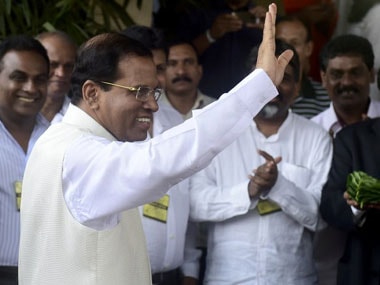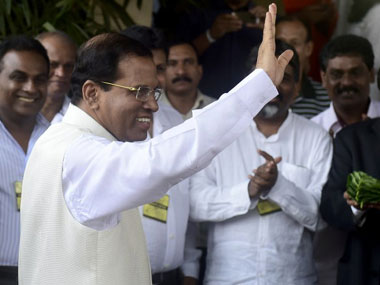Calling elections early is often a sign of hubris, and can bring nemesis with it, as the BJP found to its chagrin in 2004. Prime Minister Shinzo Abe in Japan was lucky to come roaring back with a big win in 2014. But president Mahinda Rajapaksa of Sri Lanka certainly underestimated the risk of a voter revolt, and was shown the door in the 8 January general election, which he called two years earlier than he needed to. If he had won, it would have been for an unprecedented third term as president (he had pushed through a constitutional amendment doing away with the earlier limit of two terms). There are two ways to look at this upset. On the one hand, by many accounts, Rajapaksa ran an authoritarian, corrupt and dynastic government, reminiscent of Nehru dynasty hubris-nemesis. He stuffed government with relatives and cronies: one brother was defence minister, another was finance minister, and a third was Speaker in parliament. I once met his son, a then-rising star: he was a speaker in a Bangalore conference in a session I chaired, and he brought his teleprompter along, which I thought unusual though he was a nice enough young man.[caption id=“attachment_2039837” align=“alignleft” width=“380”]
 Sri Lankan President Maithripala Sirisena. AFP[/caption] Besides, Rajapaksa’s main claim to fame was his 2009 victory over the Liberation Tigers of Tamil Eelam, which he accomplished through brutal military tactics, leading to the deaths of tens of thousands of civilians. There are many accusations of war crimes by the mainly Sinhala Sri Lankan army, yet a “lessons learnt and reconciliation” commission was widely seen as toothless, exonerating the army in 2011. The real grievances of the Tamils – who have real grievances as an often-oppressed minority, bearing the brunt of the 26-year civil war – have yet to be addressed, although it is true that the Tamil Tigers were a particularly ruthless separatist group. In addition, Rajapaksa was seen as particularly close to the Chinese: the latter build a new port facility at Hambantota in the far South of the country (conveniently close to international shipping lanes and far away from the Tamil-majority North); and they also build a new container port in Colombo, which is a commercial and strategic threat to Indian ports (they expect it will eventually carry 27 percent of India’s container traffic).
Read my previous column
on this strategic threat. Rather little is known about the new president, Maithripala Sirisena, who was one of Rajapaksa’s close associates, and health minister in his government until he abruptly changed tack in November. President Sirisena, incidentally, was acting defence minister during the 2009 campaign against the Tamil Tigers. He is also a strong Sinhala nationalist. However, he gained the support of the Tamils of the North and East, and the Muslims (some of whom are ethnic Tamils) in the East. These two groups account for 25 percent of the total electorate. Given all this, it would stand to reason that India would a priori be glad to see the change. After all, the concerns of Tamils in Sri Lanka resonate with Tamils in Tamil Nadu and a peaceful and prosperous Tamil area in Sri Lanka will be in India’s best interests, in addition to the ethical issue of justice for them. Besides, any diminution of Chinese influence will help India with its counter-string-of-pearls. On the other hand, there are some concerns that should give India pause. First of all, the new president is a relatively unknown quantity and so it’s difficult to gauge how friendly he will be to India. Besides, there have been loud rumors about the source of support for Sirisena: there are plausible theories that much of the support for him has come from the West, which has certain interests in the region. The great port of Trincomalee in eastern Sri Lanka, one of the finest and deepest natural harbors in the region, is something that many in the West have cast covetous glances at. The theories of Alfred Mahan Thayer and Nicholas John Spykman (“Rimland”) suggest that it is important to maintain a strong naval presence in the Indian Ocean, especially as China flexes its muscles in the South China Sea and further afield, and builds a powerful long-range navy. The British-American enclave of Diego Garcia, which currently serves as the US base in the area, may not be a long-term solution, as there are moves to rehabilitate the native Chagossians who were removed from the area to set up the naval base. Sri Lanka takes on a strategic importance beyond its size. During the election campaign, Rajapaksa certainly implied that Sirisena was propped up by Western interests. This is not implausible, considering that there was a great deal of European intervention (some would call it interference) in the civil war, and there were allegations of Western and specifically Christian interests in play there. For instance, many of the Tamil Tiger leaders were Christians, odd considering that most of the Tamils are Hindus. There are other religious fissures. There has been a history of conversion and counter-conversion in Sri Lanka, as some Buddhists became Christians and later reverted, leading to hurt feelings and bad blood on both sides. Also, nationalism among the majority Sinhala Buddhists have led to clashes between the strongly Buddhist Bodu Bala Sena and Muslims. Thus, there is a cauldron of complicated religious issues, and, as is their wont, Christian evangelists are fishing in these troubled waters. There is precedent all along India’s periphery. The best example is the transformation of Nepal from a Hindu kingdom to an epicenter of Christian and Muslim conversion. Similarly, in Burma, various tribes have been Christianised (e.g., the Kachins), leading to religion-based separatist tendencies, more or less the same as among groups such as the Nagas, Mizos etc. in India’s North East. Thus, the importance of the Rimland of Eurasia is being reflected in what amounts to a gold rush for, among other territories, all of the Indian subcontinent; quite conveniently, this fits in with the generic church’s need for harvesting souls. If the Rajapaksa ouster boils down to a gain for the NATO/Western powers in geopolitics or the politics of religion, then that would be bad for India. However, any nationalist Sri Lankan leader would, one hopes, realize that the ascent of another nationalist in Narendra Modi should lead to mutually benefit through improved relations between the two States.
Sri Lankan President Maithripala Sirisena. AFP[/caption] Besides, Rajapaksa’s main claim to fame was his 2009 victory over the Liberation Tigers of Tamil Eelam, which he accomplished through brutal military tactics, leading to the deaths of tens of thousands of civilians. There are many accusations of war crimes by the mainly Sinhala Sri Lankan army, yet a “lessons learnt and reconciliation” commission was widely seen as toothless, exonerating the army in 2011. The real grievances of the Tamils – who have real grievances as an often-oppressed minority, bearing the brunt of the 26-year civil war – have yet to be addressed, although it is true that the Tamil Tigers were a particularly ruthless separatist group. In addition, Rajapaksa was seen as particularly close to the Chinese: the latter build a new port facility at Hambantota in the far South of the country (conveniently close to international shipping lanes and far away from the Tamil-majority North); and they also build a new container port in Colombo, which is a commercial and strategic threat to Indian ports (they expect it will eventually carry 27 percent of India’s container traffic).
Read my previous column
on this strategic threat. Rather little is known about the new president, Maithripala Sirisena, who was one of Rajapaksa’s close associates, and health minister in his government until he abruptly changed tack in November. President Sirisena, incidentally, was acting defence minister during the 2009 campaign against the Tamil Tigers. He is also a strong Sinhala nationalist. However, he gained the support of the Tamils of the North and East, and the Muslims (some of whom are ethnic Tamils) in the East. These two groups account for 25 percent of the total electorate. Given all this, it would stand to reason that India would a priori be glad to see the change. After all, the concerns of Tamils in Sri Lanka resonate with Tamils in Tamil Nadu and a peaceful and prosperous Tamil area in Sri Lanka will be in India’s best interests, in addition to the ethical issue of justice for them. Besides, any diminution of Chinese influence will help India with its counter-string-of-pearls. On the other hand, there are some concerns that should give India pause. First of all, the new president is a relatively unknown quantity and so it’s difficult to gauge how friendly he will be to India. Besides, there have been loud rumors about the source of support for Sirisena: there are plausible theories that much of the support for him has come from the West, which has certain interests in the region. The great port of Trincomalee in eastern Sri Lanka, one of the finest and deepest natural harbors in the region, is something that many in the West have cast covetous glances at. The theories of Alfred Mahan Thayer and Nicholas John Spykman (“Rimland”) suggest that it is important to maintain a strong naval presence in the Indian Ocean, especially as China flexes its muscles in the South China Sea and further afield, and builds a powerful long-range navy. The British-American enclave of Diego Garcia, which currently serves as the US base in the area, may not be a long-term solution, as there are moves to rehabilitate the native Chagossians who were removed from the area to set up the naval base. Sri Lanka takes on a strategic importance beyond its size. During the election campaign, Rajapaksa certainly implied that Sirisena was propped up by Western interests. This is not implausible, considering that there was a great deal of European intervention (some would call it interference) in the civil war, and there were allegations of Western and specifically Christian interests in play there. For instance, many of the Tamil Tiger leaders were Christians, odd considering that most of the Tamils are Hindus. There are other religious fissures. There has been a history of conversion and counter-conversion in Sri Lanka, as some Buddhists became Christians and later reverted, leading to hurt feelings and bad blood on both sides. Also, nationalism among the majority Sinhala Buddhists have led to clashes between the strongly Buddhist Bodu Bala Sena and Muslims. Thus, there is a cauldron of complicated religious issues, and, as is their wont, Christian evangelists are fishing in these troubled waters. There is precedent all along India’s periphery. The best example is the transformation of Nepal from a Hindu kingdom to an epicenter of Christian and Muslim conversion. Similarly, in Burma, various tribes have been Christianised (e.g., the Kachins), leading to religion-based separatist tendencies, more or less the same as among groups such as the Nagas, Mizos etc. in India’s North East. Thus, the importance of the Rimland of Eurasia is being reflected in what amounts to a gold rush for, among other territories, all of the Indian subcontinent; quite conveniently, this fits in with the generic church’s need for harvesting souls. If the Rajapaksa ouster boils down to a gain for the NATO/Western powers in geopolitics or the politics of religion, then that would be bad for India. However, any nationalist Sri Lankan leader would, one hopes, realize that the ascent of another nationalist in Narendra Modi should lead to mutually benefit through improved relations between the two States.
Rajeev Srinivasan is a management consultant and columnist, and a fan of art cinema.
)